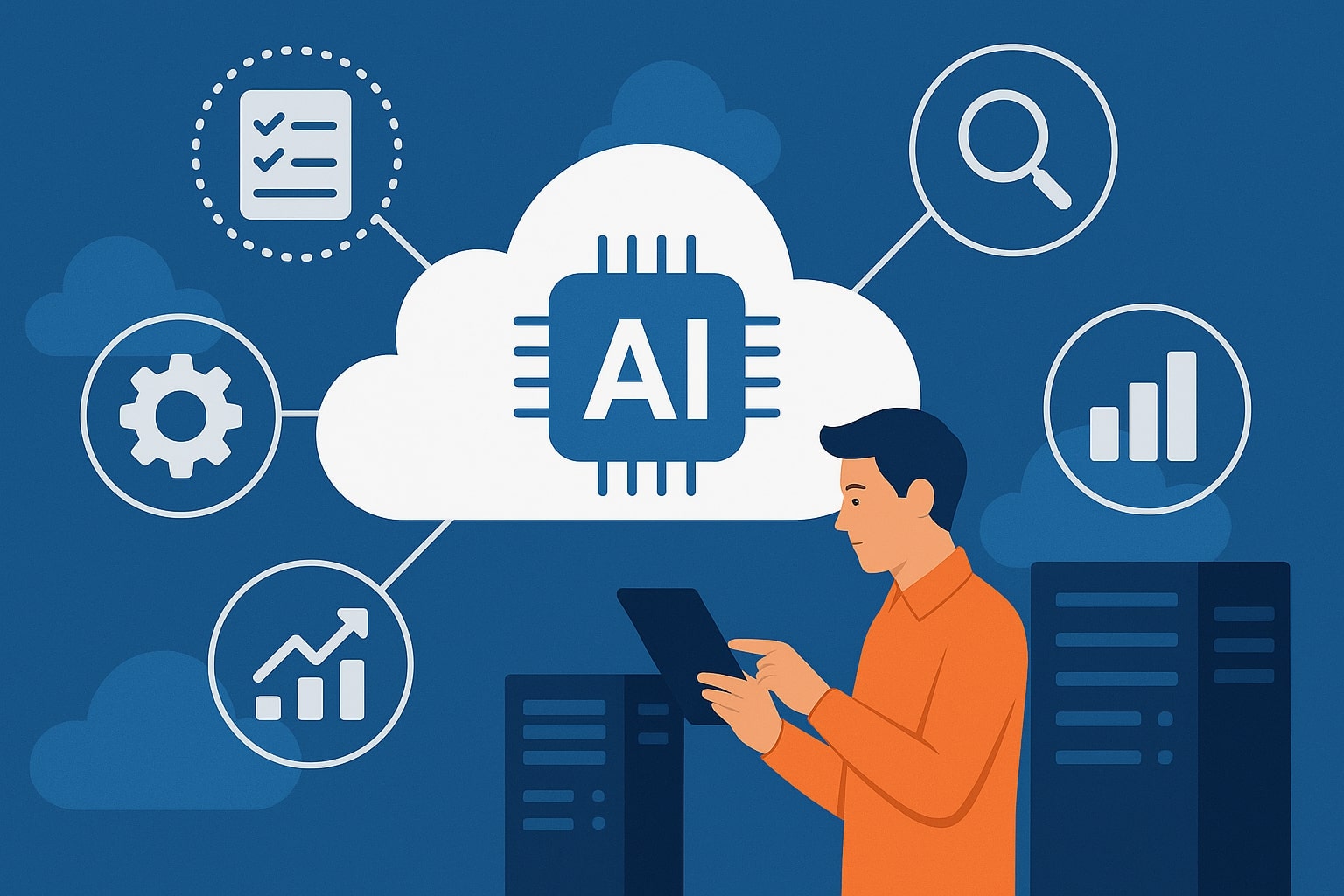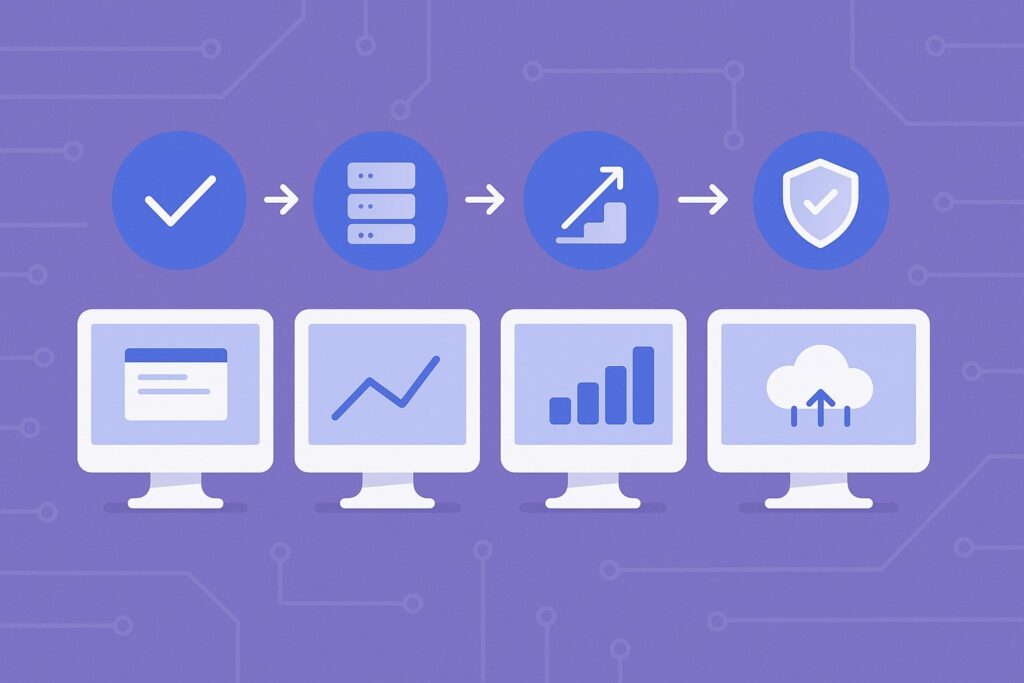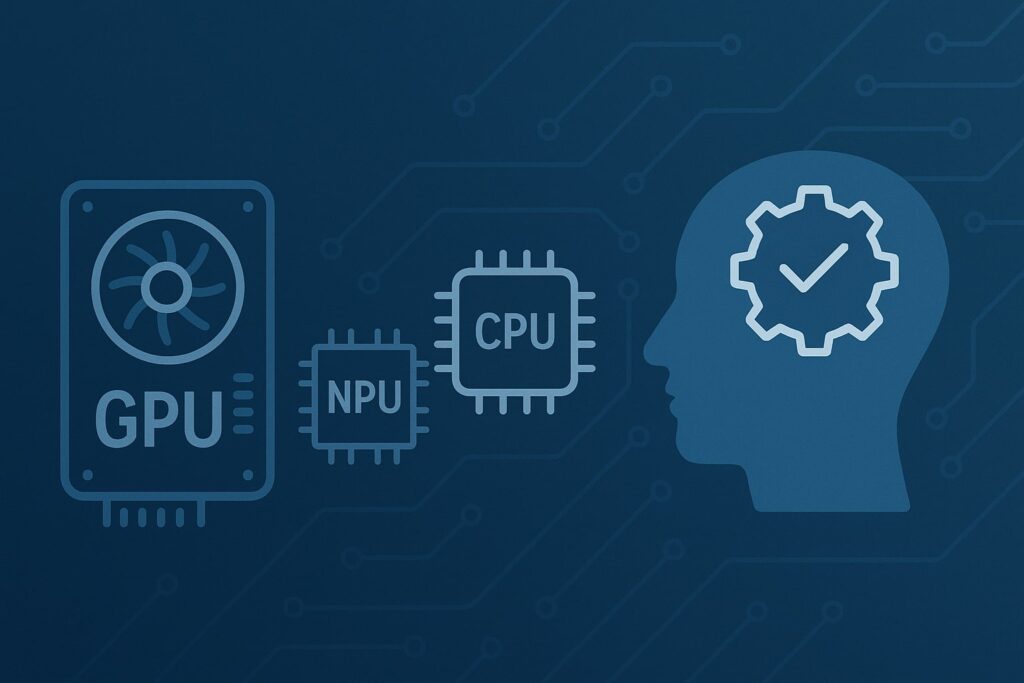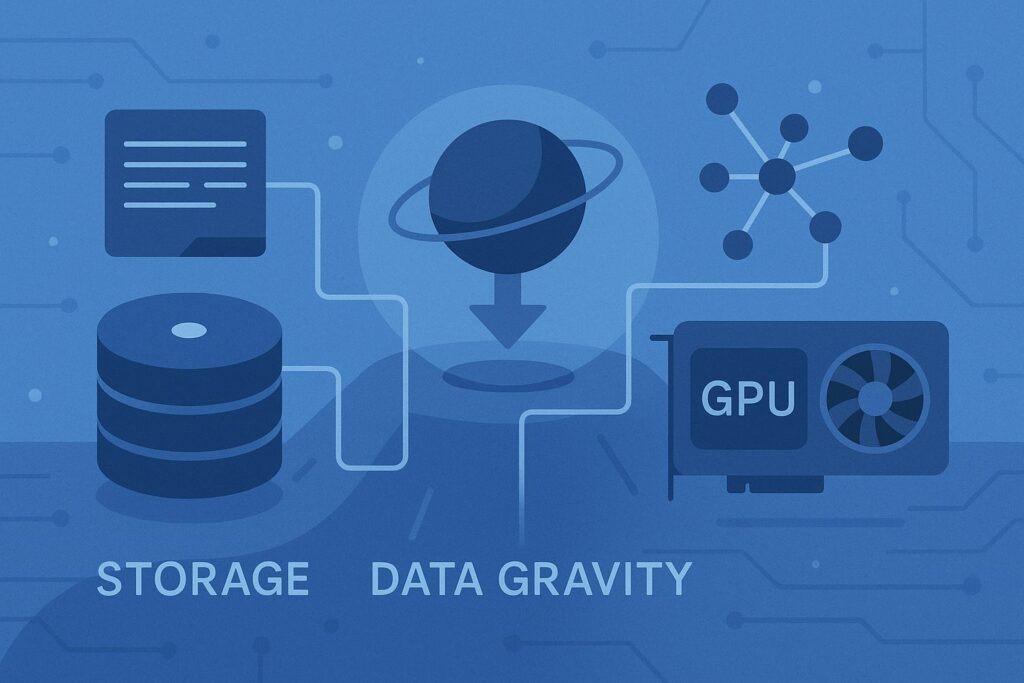
By hostmyai September 29, 2025
Choosing an AI hosting platform in 2025 feels a bit like buying a sports car that also needs to haul groceries, tow a trailer, and parallel-park itself. You need raw speed for training, rock-solid reliability for production, tight security for sensitive data, and an ecosystem that won’t go obsolete next quarter.
This guide walks you through the key criteria—compute, storage, networking, MLOps, cost control, security/compliance, support, and future-proofing—so you can evaluate vendors with confidence.
Whether you’re fine-tuning small foundation models, serving high-traffic inference for a consumer app, or orchestrating a regulated, multi-cloud pipeline, the principles here will help you avoid surprises and lock in real ROI.
The Core Buying Criteria: From “It Runs” to “It Scales, Safely”

A useful way to assess platforms is to separate “day-one” needs from “day-100” realities. Day one is all about getting your workloads running: do you have the right accelerators, drivers, container base images, and libraries? Can you spin up a Jupyter environment or submit a training job without a yak-shave?
Day 100 brings the hard parts: scaling to many nodes, shifting from experiments to govern releases, setting budgets and limits, and handling incident response. Good AI hosting abstracts the plumbing while giving you the right amount of control.
Start by listing the workloads you must support in the next year. Are you training from scratch, fine-tuning with LoRA, doing RAG over proprietary data, or primarily serving inference? Training emphasizes multi-GPU throughput, fast interconnects, and checkpointing strategies.
Inference emphasizes autoscaling, model caching, tokenizer performance, and observability (latency, tail percentiles, token throughput). Data pipelines (RAG or feature engineering) emphasize storage performance, indexing options, and data governance.
Next, examine platform ergonomics. You want Infrastructure as Code (IaC) parity for everything you can click in the console. Look for a platform that provides first-class CLIs, Terraform/Pulumi providers, and GitOps hooks so environments are reproducible.
Strong role-based access control (RBAC) and project isolation should let data scientists self-serve without giving them keys to the entire cloud kingdom. Finally, insist on clean, transparent limits and quotas—number of GPUs per region, maximum pods per node, Egress policies—so you can plan rather than scramble.
Don’t underestimate the importance of billing visibility and internal chargeback. In 2025, teams are blending commercial APIs with custom models across multiple providers.
The platforms that win let you tag costs by team, model, and environment; export raw usage; and set budget thresholds that actually stop spending instead of merely sending emails. Good hosting helps you go fast safely, and “safely” includes the budget.
Compute & Accelerators: GPUs, CPUs, NPUs, and the “Right-Size” Mindset

Compute is the headline feature, but nuance matters. If you’re training or fine-tuning, look for modern accelerators with strong memory capacity and bandwidth. HBM size and NVLink/Infinity Fabric topology determine whether a single node can handle your global batch size without gradient sharding gymnastics.
For distributed training, interconnect bandwidth (e.g., 400G+ fabrics), collective communication libraries (NCCL, RCCL), and scheduler integration (SLURM, Kubernetes operators) shape real-world throughput far more than spec sheets suggest.
Inference has different needs. Many production apps benefit from smaller, cheaper accelerators or CPU-optimized serving for quantized models. Ask for out-of-the-box support for int8/int4 quantization, speculative decoding, paged attention, KV-cache offloading, and continuous batching.
These unlock big cost reductions. Also check whether the platform supports heterogeneous fleets—mixing older GPUs for non-latency-sensitive batch jobs and newer GPUs for real-time endpoints—to avoid overpaying.
Capacity availability and placement are practical make-or-break concerns. During spikes or chip shortages, can the provider actually allocate what you need in your region? Do they offer reserved capacity or committed-use discounts with upgrade paths?
If you have data residency requirements, confirm that the exact accelerator SKUs are available in those jurisdictions. For training at scale, ask about queueing SLAs, maintenance windows, and preemption policies (especially if you plan to use spot/preemptible instances to trim cost).
Finally, developer experience around drivers and frameworks matters. You want curated container images with CUDA/ROCm, cuDNN, and compiled libraries ready to go, versioned per SDK release, and tested against common frameworks (PyTorch, JAX, TensorFlow).
Ideally, there’s a “golden image” and a changelog so you can reproduce results months later. The best platforms also provide benchmarks for typical model sizes and tasks—so you’re not the guinea pig.
Storage, Data Gravity & Vector Infrastructure: Don’t Bottleneck the GPUs

Fast computation is wasted if your data layer can’t keep up. Distinguish among three tiers: (1) hot, POSIX-style or object storage for datasets and checkpoints, (2) medium-latency vector databases or feature stores for retrieval and online personalization, and (3) cold archives for compliance and cost.
For training, prioritize high aggregate throughput to feed many GPUs—parallel reads, multi-part uploads, and checkpoint writes that don’t stall your job. For inference, focus on low-latency feature retrieval, vector search QPS, and cache hit rates.
If you’re building RAG, deeply examine the platform’s vector options. You’ll want pluggable backends (Faiss, HNSW, IVF-PQ, product quantization) and operational features: real-time upserts, eventual consistency behavior, collection sharding, backup/restore, and encryption at rest and in transit.
Look at ingestion tooling (connectors to data lakes/data warehouses, document chunking configs, tokenizer compatibility) and the cost model (storage per million vectors, read/write QPS pricing). Hybrid search (sparse + dense) is now table stakes for relevance.
Data governance must be first-class. Ask how the platform enforces per-tenant isolation at the storage layer, supports object-level ACLs, and logs access. For regulated workloads, confirm support for customer-managed keys (CMK), key rotation, and auditable key usage.
At the workflow level, you’ll need lineage: where did this dataset come from, which preprocessing steps transformed it, and which model versions trained on it? This is essential for debugging, compliance, and reproducing results.
Lastly, think about data gravity. If your data lives in Warehouse X but your GPUs are in Cloud Y, you’ll pay in both latency and egress.
In 2025, many teams adopt “compute adjacent to data” strategies: mirror hot subsets near the GPUs, keep cold data in the warehouse, and use scheduled syncs. A platform that helps you plan and automate this—with lifecycle policies and cache tiers—saves real money and reduces operational drag.
Networking, Latency, and Scaling for Real Users
Networking is where user experience lives or dies. For training clusters, the story is east-west bandwidth and low-jitter collectives. For production, its north-south traffic management: global load balancing, smart autoscaling, and multi-region failover.
Your platform should support fine-grained traffic shaping—canary releases for new models, percentage-based routing between versions, and latency-aware routing that steers requests to the closest healthy region.
Autoscaling for AI is different from web autoscaling. Token generation workloads have bursty patterns and GPU warm-up costs. Look for queue-based scaling with “pre-provisioned” capacity, minimum replicas, and rapid scale-to-zero for non-critical endpoints.
Batch workloads need separate scaling logic: scheduled windows, priority queues, and automatic backoff when downstream systems (e.g., a vector DB) saturate.
Edge and on-device inference deserve a plan if you have latency-sensitive or privacy-sensitive use cases. Some platforms now offer lightweight runtimes for CPU/NPU-class edge hardware and pipelines to compile/quantize models for specific devices. If that’s on your roadmap, insist on a supported toolchain (ONNX/MLIR/TVM, quantization-aware training, calibration datasets) and a deployment artifact format that plays nice with your CI/CD.
Finally, observability for networking is non-negotiable. You want per-request tracing across API gateway, model server, tokenizer, and retrieval steps. Tail latency (p95/p99) matters more than averages, so dashboards should highlight slow calls with context (model version, prompt size, cache hits).
Rate limiting, WAF rules, and DDoS protections are table stakes for public endpoints. If your platform can block prompt-injection patterns or enforce maximum prompt sizes at the edge, that’s a plus.
MLOps, Model Lifecycle, and Release Engineering
In 2025, the differentiator is less “can we train?” and more “can we repeatedly deliver safe, high-quality models?” A strong platform treats models like software: versioned artifacts, automated tests, staged rollouts, and rollbacks.
You should be able to pin a dataset snapshot, a preprocessing pipeline commit, and a model artifact hash to a specific release candidate, then promote it through dev → staging → production with clear approvals.
Look for built-in evaluation harnesses. Unit tests catch obvious breakages (tokenizer drift, schema mismatches), while offline evals measure perplexity, accuracy, or task-specific metrics.
You’ll also want red-team and safety evals: jailbreak resistance, prompt-injection resilience, bias/toxicity screens, PII leakage checks. The best platforms let you run these gates automatically on every candidate and store results for audits.
Feature stores and experimentation frameworks matter when many teams iterate concurrently. You want consistent offline/online feature parity, automatic training/serving skew detection, and live A/B testing for inference (with statistical rigor).
For generative systems, capture human feedback loops (RLHF or simpler rubric-based review) with traceability back to the model and prompt templates used.
Release management should include shadow mode (new model observes real traffic without user impact), progressive rollouts (1% → 10% → 50% → 100%), and auto-rollback on SLO violations (latency, error rate, safety flags).
Finally, insist on signed artifacts and supply-chain security (SBOMs, attestation) so you can prove what ran where and with which dependencies.
Security, Privacy, and Compliance: Build Trust Into the Stack
Security is not a bolt-on. Start with tenant isolation boundaries: VPC-per-project, private subnets, hardened AMIs/base images, and network policies that limit east-west movement.
Secrets management should rely on a centralized KMS with automatic rotation and least-privilege access; no plaintext API keys in environment variables. For data, enforce encryption at rest and in transit everywhere, with customer-managed keys for sensitive workloads.
Privacy considerations include data minimization (store only what you need), retention policies (auto-expire transient prompts, logs, and embeddings), and configurable redaction for PII in traces and datasets.
For generative AI, think about prompt/response logging: you need visibility for debugging and safety, but you also need consent, redaction, and strict retention to satisfy internal policy and external regulation.
Compliance will depend on your vertical and geographies. A platform should provide attestations (e.g., SOC 2, ISO 27001) and offer controls to help you meet HIPAA/PCI/GDPR/GLBA/CCPA or sector-specific rules.
Beyond paperwork, you want practical features: data residency, audit logs with immutability options, policy-as-code guardrails (e.g., OPA/Gatekeeper), and evidence collection for audits.
Don’t forget incident response: confirm how security events are detected, triaged, and communicated, and whether the platform supports your runbooks (webhooks into SIEM/SOAR, 24/7 escalation paths).
Lastly, responsible AI governance is quickly becoming a requirement. Platforms that help you document model cards, data statements, benchmark results, and known limitations—and then tie those artifacts to deployed versions—reduce risk and speed approvals. Look for first-class support for content filters, safety classifiers, and policy enforcement at inference time.
Cost, Efficiency, and Capacity Planning: Taming the GPU Bill
AI spend can spiral if you don’t instrument it. Choose platforms that give you transparent, granular billing: per-GPU-hour by SKU, storage by class, network egress, vector DB reads/writes, and per-call inference costs (tokens in/out if using LLM endpoints).
Tagging should be mandatory at resource creation—team, environment, project—so you can route costs to budgets and owners. The ability to export raw usage to your data warehouse (daily/hourly) is crucial for forecasting.
On the optimization front, expect native support for quantization, tensor parallelism, and efficient attention implementations. For training, mixed precision (bf16/fp8 where supported) and gradient checkpointing should be easy toggles.
For inference, continuous batching, KV-cache reuse, and speculative decoding can cut costs dramatically. Good platforms surface these as configuration, not bespoke code.
Spot/preemptible instances are useful for non-urgent workloads; evaluate how often they’re reclaimed and whether the platform automatically checks points and resumes.
Committed-use discounts can help for predictable baselines, but confirm upgrade paths as accelerators evolve. Capacity reservations are invaluable for launches—ask about reservation fees, change policies, and minimum terms.
Finally, embed cost SLOs into operations: budgets that are hard-stop, anomaly detection for spend spikes, and dashboards that tie cost to business metrics (e.g., cost per 1,000 requests, cost per model improvement point).
If the platform provides recommender insights—“move this endpoint to a smaller GPU,” “enable int8 quantization,” “consolidate to fewer, larger nodes”—that’s a real differentiator.
Ecosystem, Tooling & Developer Experience: Winning Hearts and PRs
Even the fastest hardware won’t matter if your team dreads using the platform. Look for native integrations with the tools your org already uses: Git providers, CI/CD systems, experiment trackers, feature stores, vector DBs, and observability stacks.
A rich CLI and SDKs (Python/TypeScript) with strong docs make everyday tasks—submitting a job, tailing logs, promoting a model—frictionless. Templates and reference architectures for common patterns (RAG, streaming chat, batch generation, fine-tuning) save weeks.
Prompt/tooling support is increasingly important for LLM apps. The platform should manage prompt templates, function/tool schemas, and evaluation datasets.
If you orchestrate multi-step agents, ask about built-in workflows that coordinate calls, handle retries, and log structured traces. For front-end teams, serverless inference endpoints with low cold-start times and native client libraries simplify integration.
Community and support matter more than you think. A public roadmap, active discussion forums, and quick responses to SDK issues are green flags.
So is a partner ecosystem—prebuilt connectors, solution integrators, and blueprints for verticals like finance, healthcare, and retail. In short, prefer platforms that feel like a thriving neighborhood, not a construction site.
Future-Proofing: Multi-Cloud, On-Prem, and the Road Ahead
Hardware and models change fast. Your hosting platform should make migrations boring. That means standard packaging (OCI containers), consistent deployment descriptors (Kubernetes, Helm, Terraform), and artifact portability (ONNX/MLIR where possible).
If you must run in multiple clouds or in a hybrid with on-prem, look for consistent control planes that manage fleets across locations, with policy and identity that follow workloads.
AI chips will diversify. Choose platforms that expose accelerators through stable abstractions (e.g., device classes and runtime capabilities) so you can adopt new SKUs without rewriting everything.
Similarly, model choices evolve: today’s LLMs may be replaced by domain-specialized models or retrieval-heavy pipelines. Favor platforms that treat models as pluggable components with unified serving layers, rather than vendor-locked endpoints.
Finally, anticipate governance tightening. Build processes now for model documentation, dataset licensing checks, and consent management.
FAQs
Q.1: How do I decide between training my own models and relying on hosted foundation models?
Answer: Start with your differentiation thesis. If your product advantage comes from proprietary data and unique task performance, owning at least part of the training or fine-tuning loop often pays off.
You’ll control architectures, tokenizers, and training data curation, which translates into better latency, lower inference cost at scale, and fewer vendor constraints.
Hosting platforms that support distributed training, dataset versioning, and automated evaluations make this path viable, especially if they also offer reserved capacity and checkpoint-aware job schedulers.
If your advantage is speed to market and broad capability, mature hosted models can be a better fit. You skip the complexity of scaling training, and you can iterate rapidly with prompt engineering, small adapters, or RAG.
Look for platforms that provide high-quality model endpoints, clear token pricing, strong safety filters, and the option to bring your own encryption and logging. Many companies blend both: hosted models for exploration and early features, custom fine-tunes where latency or quality gaps justify the investment.
Q.2: What’s the single biggest hidden cost in AI hosting, and how do I control it?
Answer: Data movement is the stealth tax. Pulling large corpora from storage to compute, shuttling embeddings to vector DBs in another region, or repeatedly exporting traces for analysis can dwarf compute savings.
The fix is architectural: co-locate hot data with compute, use lifecycle policies to keep only what you need near GPUs, and prefer intra-region traffic. Platforms that offer storage classes, edge caches, and explicit egress dashboards help you see and curb the leak.
The other hidden cost is idle capacity. Inference fleets that sit warm for rare bursts, or oversized accelerators used for tiny models, quietly drain budgets. Demand autoscaling with prewarming, continuous batching, and quantization-aware serving make a real difference.
Treat cost like an SLO: set budgets that enforce stop conditions, create alerts on cost per request, and review “rightsizing” recommendations during regular ops cadences.
Q.3: How should startups evaluate AI hosting differently than enterprises?
Answer: Startups should optimize for velocity and runway. Choose platforms that minimize setup time (curated images, one-click notebooks, managed vector DBs), and make cost visibility simple.
Favor serverless inference for early traffic, spot instances for non-urgent jobs, and clear upgrade paths as you scale. Avoid lock-in that forces a painful rewrite in six months; portability via containers and standard serving layers matters even for small teams.
Enterprises must prioritize governance and integration. Single sign-on, granular RBAC, approvals, audit trails, and integration with existing data platforms are table stakes.
You’ll also need robust compliance features—data residency, customer-managed keys, and evidence collection for audits. Finally, enterprises benefit from multi-region HA, formal SLAs, and vendor roadmaps that align with multi-year planning.
Q.4: What’s essential observability for production LLM/RAG systems?
Answer: At minimum: per-request traces that link user input → prompt template → tools/retrieval steps → model output, with timings and status codes. Capture token counts, cache hits, and tail latencies (p95/p99).
For RAG, log retrieval metrics (recall@k, source IDs), and for safety, log filter triggers and redaction events. Tie traces to model versions and dataset snapshots so you can reproduce any output.
Equally important is evaluation in the loop. Establish golden datasets and run automated offline evals on each release candidate.
For production, maintain live dashboards for quality proxies (thumbs-up/down, task success), and set triggers for rollback when quality dips or safety flags surge. Platforms that centralize traces, evals, and rollouts lower your mean time to recovery when something goes sideways.
Q.5: How do I prepare for future chips and changing model paradigms without constant rewrites?
Answer: Abstract and containerize. Package models and serving stacks in OCI images, use standard inference servers (e.g., vLLM/TensorRT-LLM/OLLAMA-style runtimes) that support multiple backends, and describe deployments declaratively (Helm/Terraform).
Where possible, compile models to portable IRs (ONNX/MLIR) and keep hardware-specific optimizations as modular configs. This lets you ride the hardware curve by swapping instance types and enabling new kernels rather than overhauling code.
Plan for migration as a feature, not a fire drill. Maintain blue/green or shadow deployments to verify behavior on new chips, run representative load tests, and compare cost/latency before flipping traffic. Choose hosting that supports mixed fleets, so you can move gradually and hedge against supply constraints.
Q.6: What are practical steps to meet security and privacy expectations without slowing teams down?
Answer: Adopt secure defaults and automate. Mandate encryption everywhere, use customer-managed keys for sensitive projects, and centralize secrets with automatic rotation. Enforce least-privilege access through RBAC tied to your identity provider.
Bake policy-as-code checks into CI/CD so deployments fail fast if they violate guardrails (e.g., public endpoints without auth, buckets without encryption).
For privacy, define retention by data class: prompts/responses, embeddings, logs, and datasets each get clear lifetimes. Add redaction to traces and PII detection to ingestion pipelines.
Document model cards and data statements as part of the release checklist so reviewers can verify suitability for the intended context. A platform that provides templates, scanners, and immutable audit logs turns governance from a blocker into a routine.
Conclusion
In 2025, the best AI hosting platforms do more than rent you GPUs. They help you move from experiments to durable products: repeatable training, safe and observable inference, governed data flows, and predictable costs.
Focus on compute fit for your workload, storage and vector layers that won’t bottleneck you, networking and autoscaling that match real user patterns, MLOps that treat models like software, and security/compliance that keeps regulators and customers confident.
Insist on portability and standards so you can adopt new chips and models without starting over. If you evaluate with this lens—capability, operability, security, and cost—you’ll pick a platform that accelerates your roadmap instead of becoming another thing you have to manage.